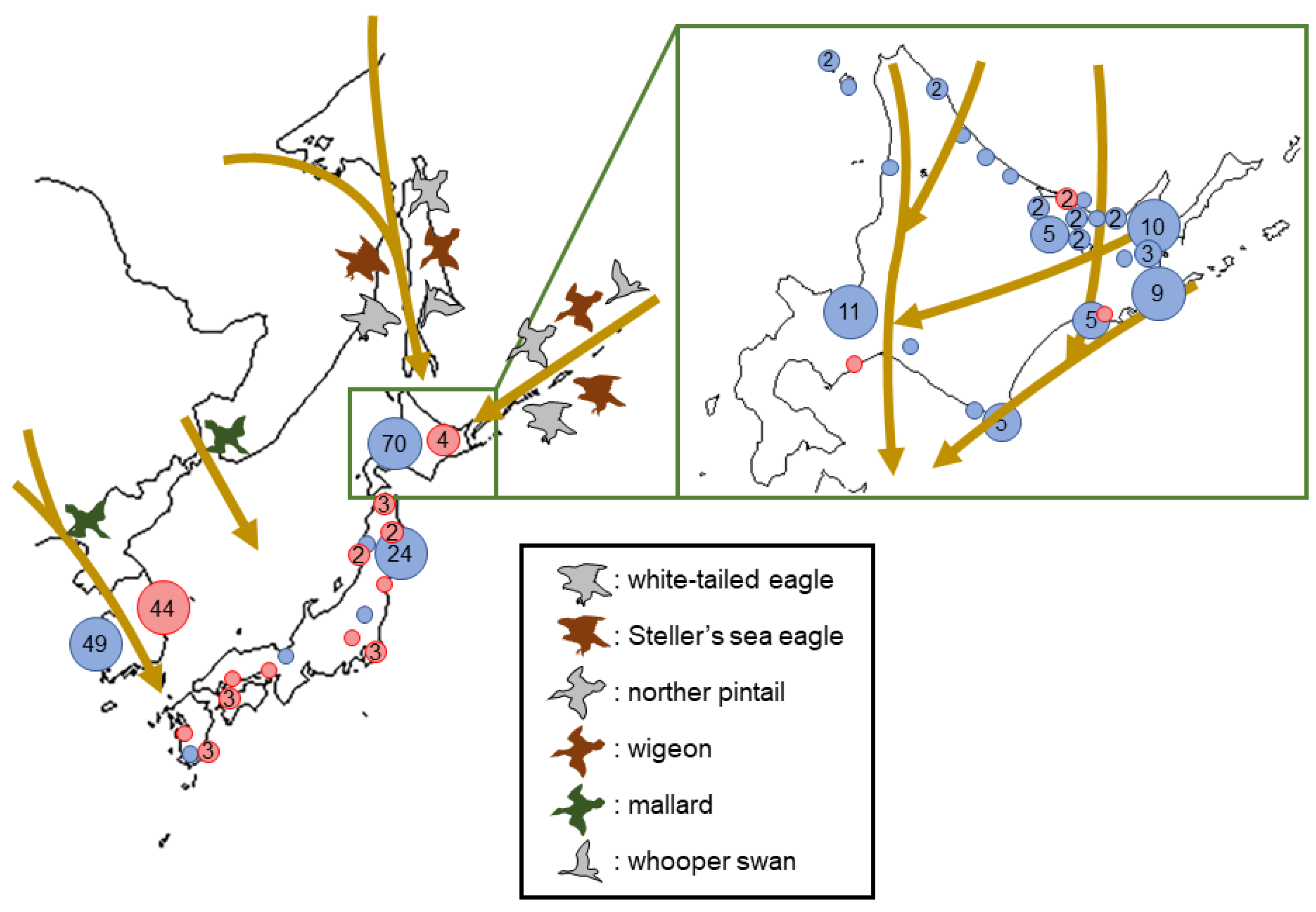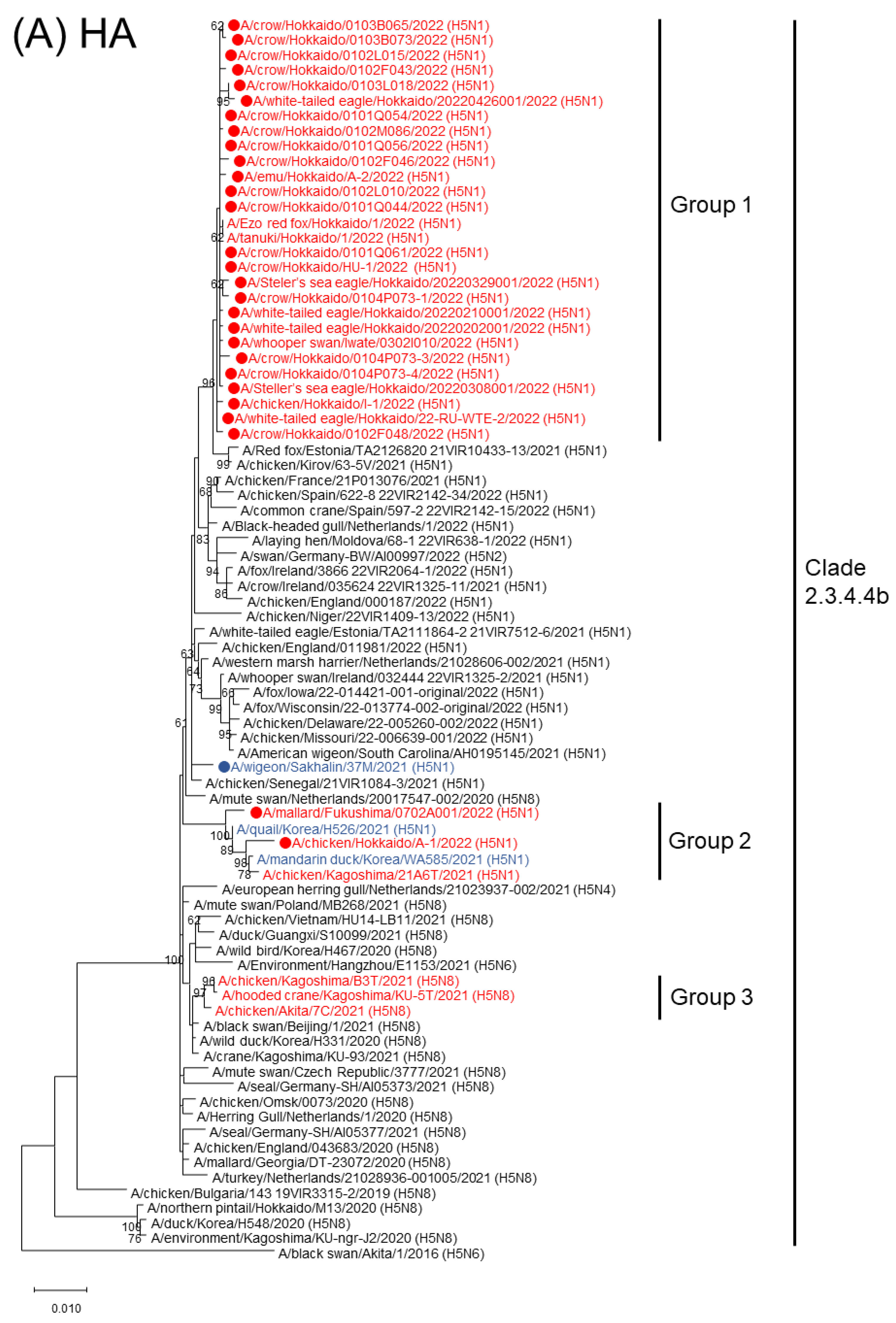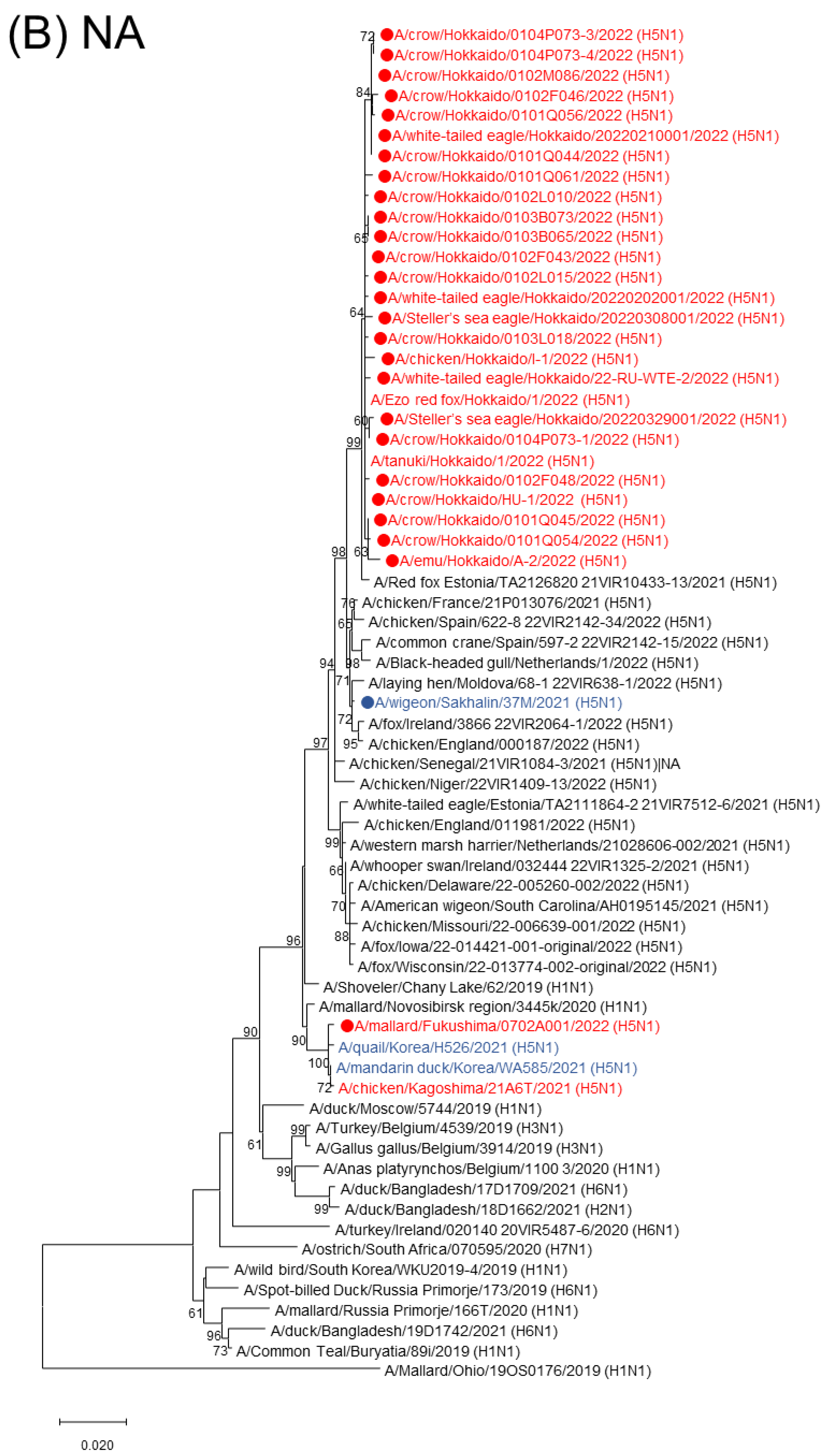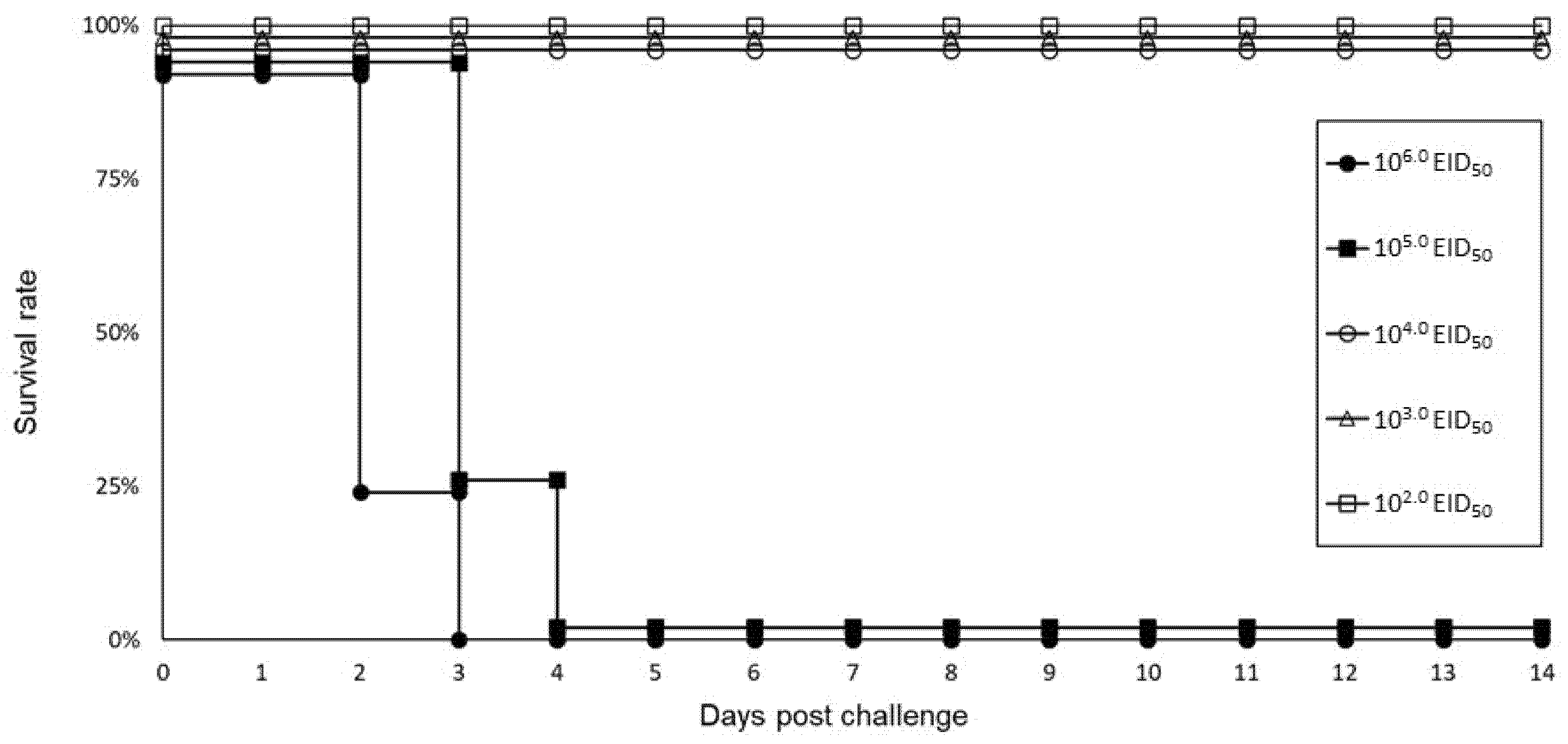Detection of New H5N1 High Pathogenicity Avian Influenza Viruses in Winter 2021–2022 in the Far East, Which Are Genetically Close to Those in Europe
Abstract
:1. Introduction
2. Materials and Methods
3. Results
4. Discussion
Supplementary Materials
Author Contributions
Funding
Institutional Review Board Statement
Informed Consent Statement
Data Availability Statement
Acknowledgments
Conflicts of Interest
References
- WHO/OIE/FAO/H5N1 Evolution Working Group. Toward a unified nomenclature system for highly pathogenic avian influenza virus (H5N1). Emerg. Infect. Dis. 2008, 14, e1. [Google Scholar] [CrossRef]
- Global Consortium for H5N8 and Related Influenza Viruses. Role for migratory wild birds in the global spread of avian influenza H5N8. Science 2016, 354, 213–217. [Google Scholar] [CrossRef]
- Baek, Y.G.; Lee, Y.N.; Lee, D.H.; Shin, J.I.; Lee, J.H.; Chung, D.H.; Lee, E.K.; Heo, G.B.; Sagong, M.; Kye, S.J.; et al. Multiple Reassortants of H5N8 Clade 2.3.4.4b Highly Pathogenic Avian Influenza Viruses Detected in South Korea during the Winter of 2020-2021. Viruses 2021, 13, 490. [Google Scholar] [CrossRef]
- Isoda, N.; Twabela, A.T.; Bazarragchaa, E.; Ogasawara, K.; Hayashi, H.; Wang, Z.J.; Kobayashi, D.; Watanabe, Y.; Saito, K.; Kida, H.; et al. Re-Invasion of H5N8 High Pathogenicity Avian Influenza Virus Clade 2.3.4.4b in Hokkaido, Japan, 2020. Viruses 2020, 12, 1439. [Google Scholar] [CrossRef]
- Khalil, A.M.; Fujimoto, Y.; Kojima, I.; Esaki, M.; Ri, K.; Masatani, T.; Matsui, T.; Ozawa, M. Genetic Characterization of H5N8 Highly Pathogenic Avian Influenza Viruses Isolated from Falcated Ducks and Environmental Water in Japan in November 2020. Pathogens 2021, 10, 171. [Google Scholar] [CrossRef]
- Sakuma, S.; Uchida, Y.; Kajita, M.; Tanikawa, T.; Mine, J.; Tsunekuni, R.; Saito, T. First Outbreak of an H5N8 Highly Pathogenic Avian Influenza Virus on a Chicken Farm in Japan in 2020. Viruses 2021, 13, 489. [Google Scholar] [CrossRef]
- European Food Safety Authority; European Centre for Disease Prevention and Control; European Union Reference Laboratory for Avian Influenza; Adlhoch, C.; Fusaro, A.; Gonzales, J.L.; Kuiken, T.; Marangon, S.; Niqueux, E.; Staubach, C.; et al. Avian influenza overview February–May 2021. EFSA J. 2021, 19, e06951. [Google Scholar] [CrossRef]
- Pohlmann, A.; King, J.; Fusaro, A.; Zecchin, B.; Banyard, A.C.; Brown, I.H.; Byrne, A.M.P.; Beerens, N.; Liang, Y.; Heutink, R.; et al. Has Epizootic Become Enzootic? Evidence for a Fundamental Change in the Infection Dynamics of Highly Pathogenic Avian Influenza in Europe, 2021. mBio 2022, 13, e00609-22. [Google Scholar] [CrossRef]
- Bevins, S.N.; Shriner, S.A.; Cumbee, J.C., Jr.; Dilione, K.E.; Douglass, K.E.; Ellis, J.W.; Killian, M.L.; Torchetti, M.K.; Lenoch, J.B. Intercontinental Movement of Highly Pathogenic Avian Influenza A(H5N1) Clade 2.3.4.4 Virus to the United States, 2021. Emerg. Infect. Dis. 2022, 28, 1006–1011. [Google Scholar] [CrossRef]
- European Food Safety Authority; European Centre for Disease Prevention and Control; European Union Reference Laboratory for Avian Influenza; Adlhoch, C.; Fusaro, A.; Gonzales, J.L.; Kuiken, T.; Marangon, S.; Niqueux, E.; Staubach, C.; et al. Avian influenza overview December 2021–March 2022. EFSA J. 2022, 20, e07289. [Google Scholar] [CrossRef]
- Sagong, M.; Lee, Y.N.; Song, S.; Cha, R.M.; Lee, E.K.; Kang, Y.M.; Cho, H.K.; Kang, H.M.; Lee, Y.J.; Lee, K.N. Emergence of clade 2.3.4.4b novel reassortant H5N1 high pathogenicity avian influenza virus in South Korea during late 2021. Transbound. Emerg. Dis. 2022, 69, e3255–e3260. [Google Scholar] [CrossRef]
- Cui, P.; Shi, J.; Wang, C.; Zhang, Y.; Xing, X.; Kong, H.; Yan, C.; Zeng, X.; Liu, L.; Tian, G.; et al. Global dissemination of H5N1 influenza viruses bearing the clade 2.3.4.4b HA gene and biologic analysis of the ones detected in China. Emerg. Microbes Infect. 2022, 11, 1693–1704. [Google Scholar] [CrossRef]
- Okuya, K.; Mine, J.; Tokorozaki, K.; Kojima, I.; Esaki, M.; Miyazawa, K.; Tsunekuni, R.; Sakuma, S.; Kumagai, A.; Takadate, Y.; et al. Genetically Diverse Highly Pathogenic Avian Influenza A(H5N1/H5N8) Viruses among Wild Waterfowl and Domestic Poultry, Japan, 2021. Emerg. Infect. Dis. 2022, 28, 1451–1455. [Google Scholar] [CrossRef]
- Onuma, M.; Kakogawa, M.; Yanagisawa, M.; Haga, A.; Okano, T.; Neagari, Y.; Okano, T.; Goka, K.; Asakawa, M. Characterizing the temporal patterns of avian influenza virus introdution into Japan by migratory birds. J. Vet. Med. Sci. 2017, 79, 943–951. [Google Scholar] [CrossRef]
- Flight Routes and Movement of Swans and Ducks. Available online: https://www.env.go.jp/nature/dobutsu/bird_flu/migratory/migration_route.html (accessed on 26 September 2022). (In Japanese).
- Habitat Status of Sea Eagles (Haliaeetinae) during Migration and Wintering. Available online: https://www.env.go.jp/content/900494529.pdf (accessed on 26 September 2022). (In Japanese).
- Ministry of Agriculture Forestry and Fisheries. Information on Avian Influenza in FY. 2021. Available online: https://www.maff.go.jp/j/Usyouan/douei/tori/r3_hpai_kokunai.html (accessed on 20 July 2022). (In Japanese)
- Ministry of Environment. Information on Avian Influenza. Available online: https://www.env.go.jp/nature/dobutsu/bird_flu/ (accessed on 25 July 2022). (In Japanese)
- Food and Agriculture Organization of the United Nations. EMPRS-i +Global Animal Disease Information System. Available online: https://empres-i.apps.fao.org/diseases (accessed on 20 July 2022).
- Kakogawa, M.; Onuma, M.; Saito, K.; Watanabe, Y.; Goka, K.; Asakawa, M. Epidemiologic Survey of Avian Influenza Virus Infection in Shorebirds Captured in Hokkaido, Japan. J. Wildl. Dis. 2020, 56, 651–657. [Google Scholar] [CrossRef]
- Heine, H.G.; Foord, A.J.; Wang, J.; Valdeter, S.; Walker, S.; Morrissy, C.; Wong, F.Y.; Meehan, B. Detection of highly pathogenic zoonotic influenza virus H5N6 by reverse-transcriptase quantitative polymerase chain reaction. Virol. J. 2015, 12, 18. [Google Scholar] [CrossRef]
- Kida, H.; Yanagawa, R. Isolation and characterization of influenza a viruses from wild free-flying ducks in Hokkaido, Japan. Zentralbl. Bakteriol. Orig. A 1979, 244, 135–143. [Google Scholar]
- Kumar, S.; Stecher, G.; Tamura, K. MEGA7: Molecular Evolutionary Genetics Analysis Version 7.0 for Bigger Datasets. Mol. Biol. Evol. 2016, 33, 1870–1874. [Google Scholar] [CrossRef]
- Reed, L.J.; Muench, H. A simple method of estimating fifty per cent endpoints. Am. J. Epidemiol. 1938, 27, 493–497. [Google Scholar] [CrossRef]
- European Food Safety Authority; European Centre for Disease Prevention and Control; European Union Reference Laboratory for Avian Influenza; Adlhoch, C.; Fusaro, A.; Gonzales, J.L.; Kuiken, T.; Marangon, S.; Niqueux, E.; Staubach, C.; et al. Avian influenza overview September–December 2021. EFSA J. 2021, 19, e07108. [Google Scholar] [CrossRef]
- Tanimura, N.; Tsukamoto, K.; Okamatsu, M.; Mase, M.; Imada, T.; Nakamura, K.; Kubo, M.; Yamaguchi, S.; Irishio, W.; Hayashi, M.; et al. Pathology of fatal highly pathogenic H5N1 avian influenza virus infection in large-billed crows (Corvus macrorhynchos) during the 2004 outbreak in Japan. Vet. Pathol. 2006, 43, 500–509. [Google Scholar] [CrossRef]
- Hiono, T.; Okamatsu, M.; Matsuno, K.; Haga, A.; Iwata, R.; Nguyen, L.T.; Suzuki, M.; Kikutani, Y.; Kida, H.; Onuma, M.; et al. Characterization of H5N6 highly pathogenic avian influenza viruses isolated from wild and captive birds in the winter season of 2016-2017 in Northern Japan. Microbiol. Immunol. 2017, 61, 387–397. [Google Scholar] [CrossRef]
- Krone, O.; Globig, A.; Ulrich, R.; Harder, T.; Schinkothe, J.; Herrmann, C.; Gerst, S.; Conraths, F.J.; Beer, M. White-Tailed Sea Eagle (Haliaeetus albicilla) Die-Off Due to Infection with Highly Pathogenic Avian Influenza Virus, Subtype H5N8, in Germany. Viruses 2018, 10, 478. [Google Scholar] [CrossRef]
- Van den Brand, J.M.; Krone, O.; Wolf, P.U.; van de Bildt, M.W.; van Amerongen, G.; Osterhaus, A.D.; Kuiken, T. Host-specific exposure and fatal neurologic disease in wild raptors from highly pathogenic avian influenza virus H5N1 during the 2006 outbreak in Germany. Vet. Res. 2015, 46, 24. [Google Scholar] [CrossRef]
- Engelsma, M.; Heutink, R.; Harders, F.; Germeraad, E.A.; Beerens, N. Multiple Introductions of Reassorted Highly Pathogenic Avian Influenza H5Nx Viruses Clade 2.3.4.4b Causing Outbreaks in Wild Birds and Poultry in The Netherlands, 2020–2021. Microbiol. Spectr. 2022, 10, e0249921. [Google Scholar] [CrossRef]




| Virus | Gene | Most Homologous Strain | Homology | Accession Number |
|---|---|---|---|---|
| A/white-tailed eagle/Hokkaido/22-RU-WTE-2/2022 (H5N1) | PB2 | A/buzzard/Germany-SH/AI07099/2021 (H5N1) | 99.74% | EPI2009974 |
| PB1 | A/buzzard/Germany-SH/AI07099/2021 (H5N1) | 99.74% | EPI2009973 | |
| PA | A/white-tailed eagle/Sweden/SVA211201SZ0380/FB004721/M-2021 (H5N1) | 99.59% | EPI1943097 | |
| HA | A/buzzard/Germany-SH/AI07099/2021 (H5N1) | 99.60% | EPI2009967 | |
| NP | A/buzzard/Germany-SH/AI07099/2021 (H5N1) | 99.74% | EPI2009970 | |
| NA | A/greylag goose /Sweden/SVA211111SZ0376/FB004497/M-2021 (H5N1) | 99.65% | EPI1938854 | |
| M | A/swan/Romania/10986 22VIR2749-8/2022 (H5N1) | 99.60% | EPI2015036 | |
| NS | A/greylag goose/Denmark/24309-1.01/2021-10-27 (H5N1) | 99.77% | EPI2015081 | |
| A/crow/Hokkaido/0103B065/2022 (H5N1) | PB2 | A/greylag goose /Sweden/SVA211111SZ0376/FB004497/M-2021 (H5N1) | 99.74% | EPI1938849 |
| PB1 | A/white-tailed eagle/Sweden/SVA211201SZ0380/FB004721/M-2021 (H5N1) | 99.66% | EPI1943096 | |
| PA | A/white-tailed eagle/Sweden/SVA211201SZ0380/FB004721/M-2021 (H5N1) | 99.64% | EPI1943097 | |
| HA | A/chicken/Kirov/63-5V/2021 (H5N1) | 99.49% | EPI1958041 | |
| NP | A/white-tailed eagle/Sweden/SVA211201SZ0380/FB004721/M-2021 (H5N1) | 99.74% | EPI1943099 | |
| NA | A/greylag goose /Sweden/SVA211111SZ0376/FB004497/M-2021 (H5N1) | 99.72% | EPI1938854 | |
| M | A/swan/Romania/10986 22VIR2749-8/2022 (H5N1) | 99.80% | EPI2015036 | |
| NS | A/barnacle goose/Sweden/SVA211111SZ0376/FB004496/2021 (H5N1) | 100.00% | EPI1938848 |
Publisher’s Note: MDPI stays neutral with regard to jurisdictional claims in published maps and institutional affiliations. |
© 2022 by the authors. Licensee MDPI, Basel, Switzerland. This article is an open access article distributed under the terms and conditions of the Creative Commons Attribution (CC BY) license (https://creativecommons.org/licenses/by/4.0/).
Share and Cite
Isoda, N.; Onuma, M.; Hiono, T.; Sobolev, I.; Lim, H.Y.; Nabeshima, K.; Honjyo, H.; Yokoyama, M.; Shestopalov, A.; Sakoda, Y. Detection of New H5N1 High Pathogenicity Avian Influenza Viruses in Winter 2021–2022 in the Far East, Which Are Genetically Close to Those in Europe. Viruses 2022, 14, 2168. https://doi.org/10.3390/v14102168
Isoda N, Onuma M, Hiono T, Sobolev I, Lim HY, Nabeshima K, Honjyo H, Yokoyama M, Shestopalov A, Sakoda Y. Detection of New H5N1 High Pathogenicity Avian Influenza Viruses in Winter 2021–2022 in the Far East, Which Are Genetically Close to Those in Europe. Viruses. 2022; 14(10):2168. https://doi.org/10.3390/v14102168
Chicago/Turabian StyleIsoda, Norikazu, Manabu Onuma, Takahiro Hiono, Ivan Sobolev, Hew Yik Lim, Kei Nabeshima, Hisako Honjyo, Misako Yokoyama, Alexander Shestopalov, and Yoshihiro Sakoda. 2022. "Detection of New H5N1 High Pathogenicity Avian Influenza Viruses in Winter 2021–2022 in the Far East, Which Are Genetically Close to Those in Europe" Viruses 14, no. 10: 2168. https://doi.org/10.3390/v14102168
APA StyleIsoda, N., Onuma, M., Hiono, T., Sobolev, I., Lim, H. Y., Nabeshima, K., Honjyo, H., Yokoyama, M., Shestopalov, A., & Sakoda, Y. (2022). Detection of New H5N1 High Pathogenicity Avian Influenza Viruses in Winter 2021–2022 in the Far East, Which Are Genetically Close to Those in Europe. Viruses, 14(10), 2168. https://doi.org/10.3390/v14102168






